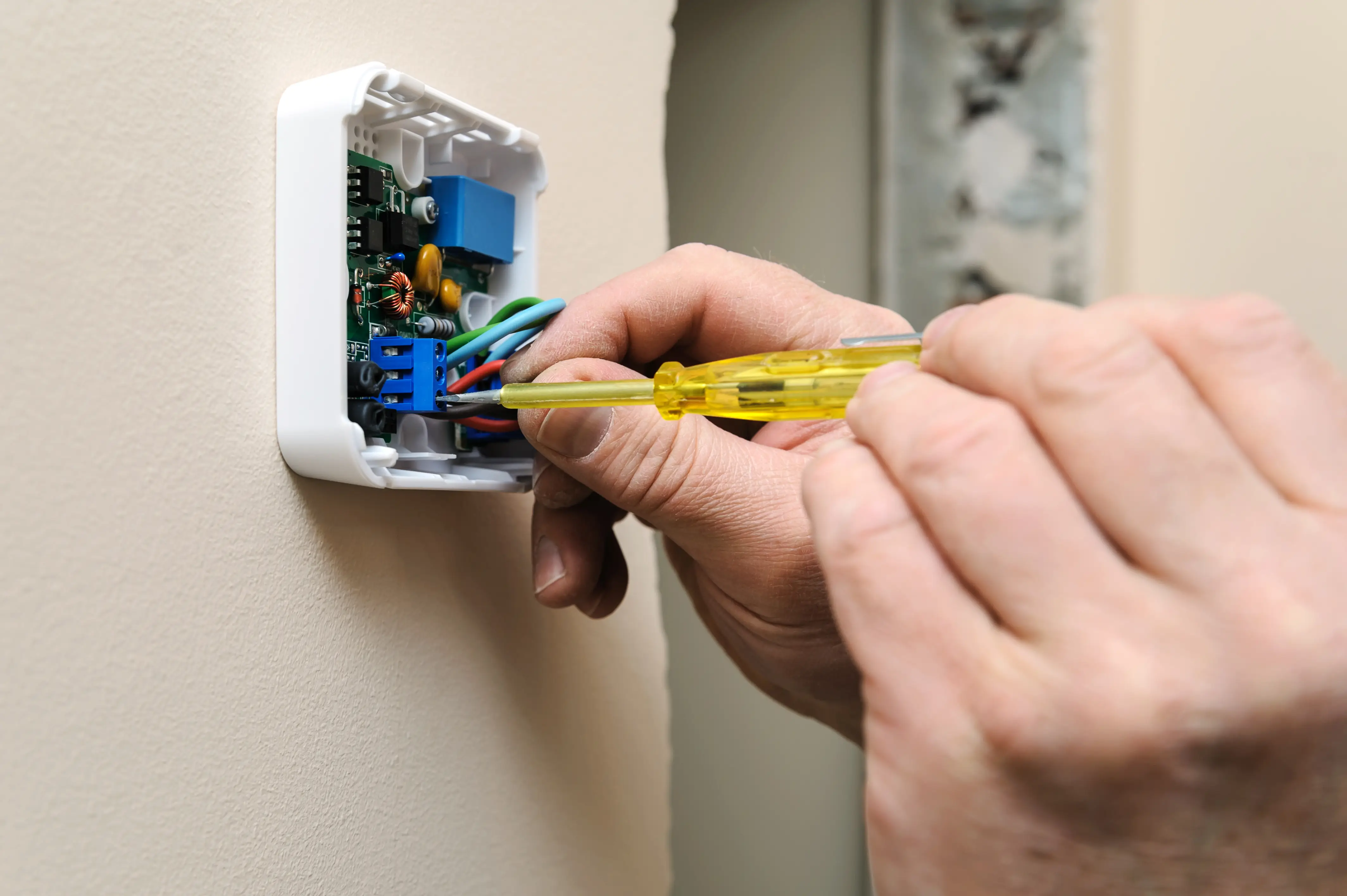Thermostat Wire Color Code Guide

Last updated:2/09/2024
Reviewed:by our team of HVAC professionals
Whether you’re trying to fix your thermostat or installing a new smart thermostat, this thermostat wire color code guide will help you avoid some common DIY wiring problems. However, please note that this article references the most common thermostat wire colors used. Your thermostat may contain different colored HVAC thermostat wires. If you have any doubts, request professional thermostat installation.
Below are the common thermostat wire colors:
How Do You Identify Thermostat Wires?
Before identifying your HVAC thermostat wires, turn your HVAC unit and thermostat off. Do this by switching the circuit breaker to the ‘off’ position. Once the power is off, remove the front cover from the thermostat. While old thermostat wiring doesn’t always adhere to color-coding trends, most newer units do. These wires are typically labeled on the HVAC unit with a series of letters indicating what each wire does. Letters correspond to the color of the wire. Here is a quick summary of the different color wires and what each one does.
The White Wire
The white wire on your thermostat connects to your heating system. It connects your thermostat to your air handler or furnace. The white wire connects to terminal W in most industry-standard thermostats. If your HVAC system has multiple heating stages, then you may find more than one white wire.
Yellow Wires
The yellow wires on your thermostat connect to your compressor. They control your air conditioning system by turning the compressor on and off. The yellow wires connect your thermostat to your compressor contactor via the air handler. The yellow wires connect to the Y terminals on your thermostat.
The Green Wire
The green wire on your thermostat connects to the fan of your furnace or air handler. It connects your thermostat to the air handler or furnace. The green wire connects to terminal G on your thermostat.
The Orange Wire
The orange thermostat wire connects to your heat pump if you have one. It connects your thermostat to your outdoor condenser to reverse valve operations from hot to cold. The orange wire connects to terminal O on your thermostat.
The orange wire only applies to homeowners who have an air-source heat pump. Only air-source heat pumps connect to your outdoor condenser. Homeowners with geothermal heat pumps can disregard the orange wire.
Red Wires
Red wires are ‘hot’ because they connect to the power source. You may see an Rc and/or an Rh wire. This wire will supply power to your thermostat.
The Rc Wire
The Rc wires on your thermostat are for air conditioning systems or dual transformer systems. Dual transformer systems refer to a setup with a cooling and heating transformer. Rc wires connect to the RC terminals on your thermostat.
The Rh Wire
The Rh wire on your thermostat connects to your heating system as opposed to your cooling system.However, if you have a dual transformer setup, this wire may just be labeled as ‘R’ without an ‘h’ included. The Rh wire connects to the RH terminal on your thermostat.
The Blue or C Wire
Blue wires (‘B’) are also called C wires because they are common wires. C wires are necessary for any smart thermostat that requires a 24/7 power source, regardless of type of heat pump you have. (Make sure to choose a thermostat that is compatible with your specific heat pump.)
C wires, whether blue or other color, may apply to every thermostat, but blue C wires are primarily used for thermostats that are attached to a heat pump. This wire connects to terminal B on your thermostat.
Yes, thermostat color wiring can be confusing, which is why it’s best to leave this task to an expert, especially if you're feeling uncertain about where to connect each wire.
Does Thermostat Wire Color Matter?
Yes, thermostat color code wiring does matter a great deal. The color coding indicates which wire goes to which port. In some cases, the color of the wire doesn’t necessarily mean it connects to the same color on the board. This may be the case when the wires have been swapped (on either end) or if there’s a splice in the wire that is incorrectly matched to a specific color.
What Happens if You Wire a Thermostat Incorrectly?
While HVAC thermostat wires seem fairly straightforward, there are several configurations to keep in mind when installing your new thermostat. Depending on the HVAC system you have, it may allow you to use a simple mechanical or digital room thermostat. Depending on the amount of control you want, you can install a thermostat that is simply designed for climate control or one that is a multi-system communicating thermostats.
If you’re considering replacing or installing a thermostat yourself, you’ll need some basic electrical knowledge and a general understanding of the equipment you’re using. Even armed with these, you may struggle to wire a thermostat correctly. Novice installers may blow a circuit breaker or experience electric shocks. If you wire a thermostat wrong, you may damage the thermostat, the electrical system, or the HVAC unit itself, which makes the entire installation process more frustrating. You may find yourself testing thermostat wires for hours, trying to get them right.
Trust Aire Serv for Your Thermostat Wiring
There is one sure-fire way to ensure your thermostat functions reliably, hire a professional for thermostat installation. In some cases a thermostat manufacturer will void the warranty if the installation is not performed by a professional. While the warranty might not seem like a big deal, it does offer protection against defects and malfunctions. Should your thermostat suddenly stop working, you can avoid paying out of pocket for any repairs or replacement if covered under the warranty.
Your local Aire Serv team wants you to help you get the best performance from your HVAC unit. Professional HVAC installation, repairs, and maintenance can improve comfort, energy efficiency, and reliability. The next time you’re in the market for a new thermostat, skip the complicated HVAC wiring diagram thermostat and call the professionals instead. We work night and day to ensure we’re there when you need us most for your heating and cooling needs.
Call us or request an appointment online to get started.
Disclaimer
This article is intended for general guidance only and may not be applicable to every situation. You are responsible for determining the proper course of action for your property and your situation. Aire Serv is not responsible for any damages that occur as a result of any advice or guidance derived from blog content.
 Click to call
Click to call


